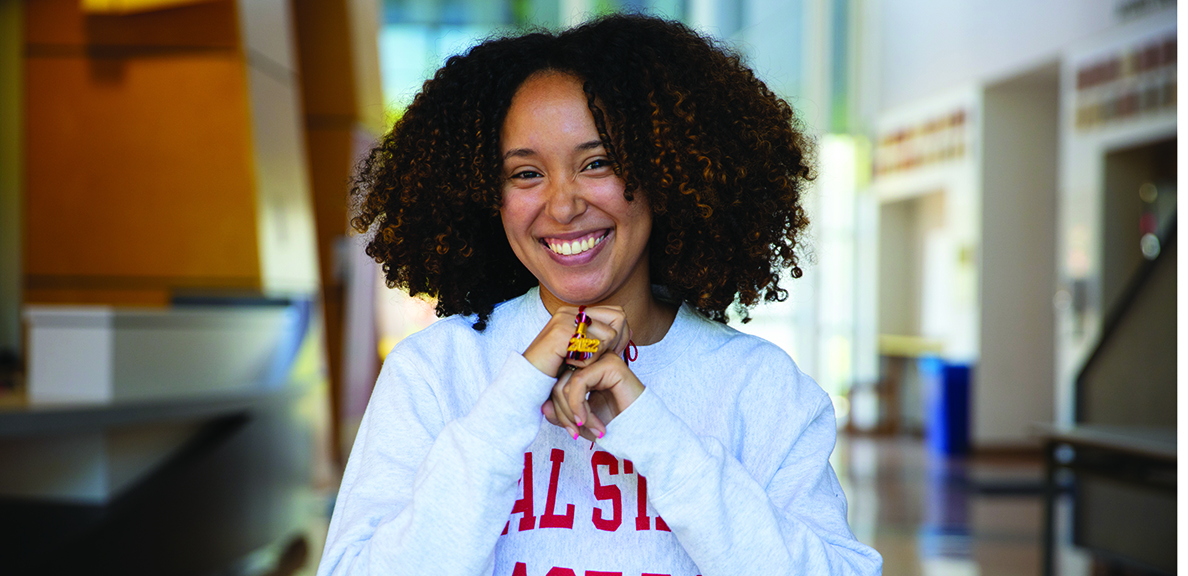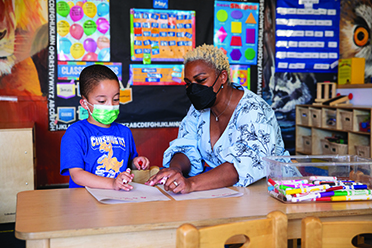
Inspiring Perspectives
BY Cathi Douglas
PHOTOGRAPHY BY Garvin Tso
July 11, 2022
While the darkest days of the coronavirus pandemic may lie behind us, its historic aftereffects live on.
Profound challenges wrought by two years of isolation provide new perspectives on our world — and can lead to innovative solutions for positive change.
Every facet of American society today struggles to address issues highlighted by the pandemic, including healthcare disparities in diverse communities, unjust economic burdens on essential workers, and ongoing socioeconomic inequalities in underserved neighborhoods.
Amid the pandemic raged Black Lives Matter protests, where people demanded equal justice for all Americans and brought to the forefront critical socioeconomic, political, and humanitarian challenges.
“This pandemic laid bare all of the disparities in our society,” notes Michael Stanton, Cal State East Bay assistant professor of health sciences. “It exposed health and information access and trust issues within the larger health care system. There were heartbreaking examples of how unequal we are, which made things really hard.
“For people who had resources, remote work was easy,” Stanton continues. “Essential workers didn’t have that luxury, and the pandemic exposed that disparity.”
He hopes that the pandemic prompts empathy and respect for teachers, taxi drivers, food preparers, and those who collect our trash. “I’m hopeful that this experience helped us understand how important these people are, and that their contribution to society is important.
“I’m hopeful that we understand and compensate these people fairly, and give them the opportunities to be successful in their lives.”
Recent health science graduate Hershie Collins researched COVID-19’s effects on underserved communities for a Cal State East Bay class and discovered that a disproportionate number of African Americans, Native Americans, and Latinos were infected and died due to a lack of accessible health care and testing clinics, overcrowded housing or poverty.
“The pandemic hit people of color more than anyone else,” she explains. “Realizing that is important for everyone so that our nation can address strategies to address the needs of communities of color.”
Collins, who wants to become a registered nurse, works as a patient access representative at Stanford Hospital. One of 11 siblings raised in San Mateo by her grandmother, she is the first in her family to earn a bachelor’s degree and says the lessons of the pandemic have inspired her to work toward improving access to health care for all — including mental health care.
“The pandemic took a toll on the health of many students,” she says. “Doing school online and staying home all day during the pandemic created a lack of social skills; we were all accustomed to being inside, online, and not socializing with others.
“Now that schools are open and classes are in person, some students may have difficulties communicating with others.”
For families, the pandemic meant either painful separations from one another or the opportunity to isolate together.
“In a crisis, families can either pull together or separate emotionally,” observes Robert Williams, dean of Cal State East Bay’s College of Education and Allied Studies.
“This pandemic crisis pulled some families together and they spent time as a team learning what their children were doing in school, and realizing the hard work that teachers do,” Williams says. “It also created separation in families, because some people felt more isolated even in the same home because of domestic violence and other issues.”
In many families, however, members adjusted in ways that were remarkable, he adds. “The more resourceful families found other resources to create bubbles and support or got creative with their own extended family networks of aunts, uncles, cousins and meemaws who helped out with child care and relief.
“We all found ways to cope with the sudden and unexpected transition.”
The COVID-19 pandemic gave individuals the unique opportunity to examine their work lives and living situations, Williams notes, and some families chose to move out of the Bay Area after assessing their careers and home lives.
“A lot of workers who had the chance to reexamine their lives and chose different fields and made new choices for their quality of life.”
The pandemic meant that Bay Area parents who provide essential services found themselves struggling to remain working while finding places for their children to receive early childhood education.
That burden challenged Cal State East Bay alumna Makinya Ward, who has operated Kids Konnect Infant Care and Preschool in five East Bay locations for two decades. The pandemic was “a life-and-death situation” and a tremendous burden for Ward as both an employer and provider of essential services.
Yet, Ward notes, it also provided an important opportunity for voices not usually heard to have center stage.
“There is a lot of pushback against the system that has failed women and people of color,” she says. “The good that came out of the pandemic was some change and the shining of light on injustices.”
Ward also serves as public policy co-chair of Californians for Quality Early Learning, a nonprofit organization that provides professional development and support for California child care educators. She believes that COVID-19 is an eye-opener for families across the country.
“I think we understand more about how important preschool education is to early learning, and how important it is for our economy to function as parents join the workforce,” she says.
“I want to believe that child care is going to be pushed into a better place for enough space to be available for every child,” she adds, “but unless federal, state, local governments and businesses support it, child care won’t be available to every family.”
Williams is pleased that Cal State East Bay faculty and administrators are learning to be flexible and noble as university leaders in light of the pandemic’s lessons.
“I know at East Bay we are asking questions about the lens through which the social sciences, math, education, recreational tourism and hospitality are being taught,” he says. “We’re asking whose story is being told.”
He believes it is critical that the university and its teachers remember what their purpose is, and focus on that despite the “incredible divide in this country.
“Our future is fraught with divides this country hasn’t seen since the pre-1900s,” he notes. “We must focus on educating students and training them to improve the human condition, to be changemakers in our traditions, to lead with an eye toward social justice.”
While doing so, Stanton, who is often quoted on the pandemic’s health science issues, says it’s important to acknowledge that scientists “have done the impossible” in successfully creating an effective vaccine in a year’s time.
In addition, he adds, he is inspired by the way “national, state and local communities banded together to support each other in incredible ways.
“It has been amazing to see people get through what we’ve gone through, and to support each other,” he notes. “Given how hard we’ve worked to overcome the pandemic, we need to be empathetic to each other and to ourselves.
“We’ve been through a life-changing experience and that means more time to ourselves at the end of the day to appreciate our families, more sleep, and more exercise,” he says. “We need to be kind to ourselves.”

Share this story